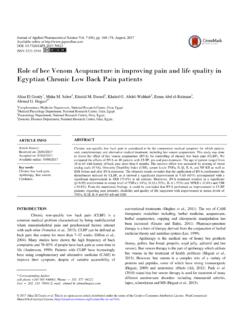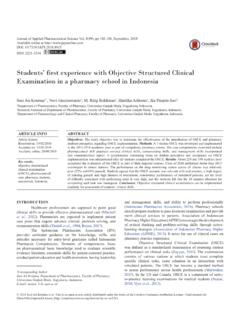Transcription of Drug-excipient interaction and its importance in dosage ...
1 Journal of Applied Pharmaceutical Science 01 (06); 2011: 66-71 ISSN: 2231-3354 Received: 29-07-2011 Revised on: 02-08-2011 Accepted: 04-08-2011 Nishath Fathima, Tirunagari Mamatha, Husna Kanwal Qureshi, Nandagopal Anitha and Jangala Venkateswara Rao Sultan-Ul-Uloom College of Pharmacy, Banjara Hills, Hyderabad - 500034, , India. For Correspondence: Nishath Fathima Department of Quality assurance, Sultan-Ul-Uloom College of Pharmacy, Banjara Hills, Hyderabad, India. Drug-excipient interaction and its importance in dosage form development Nishath Fathima, Tirunagari Mamatha, Husna Kanwal Qureshi, Nandagopal Anitha and Jangala Venkateswara Rao ABSTRACT excipients are included in dosage forms to aid manufacture, administration or absorption. Although considered pharmacologically inert, excipients can initiate, propagate or participate in chemical or physical interactions with drug compounds, which may compromise the effectiveness of a medication.
2 Exicipients are not exquisitely pure. Even for the most commonly used excipients , it is necessary to understand the context of their manufacture in order to identify potential active pharmaceutical ingredients interactions with trace components. Chemical interactions can lead to degradation of the active ingredient, thereby reducing the amount available for therapeutic effect. Physical interactions can affect rate of dissolution, uniformity of dose or ease of administration. Key words: Excipient, Drug, interaction , Physical, Chemical. INTRODUCTION Pharmaceutical dosage form is a combination of active pharmaceutical ingredients (API) and excipients . excipients are included in dosage forms to aid manufacture, administration or absorption (Crowley and Martini).The ideal excipients must be able to fulfill the important functions dose, stability and release of API from the formulation. Although considered pharmacologically inert, excipients can initiate, propagate or participate in chemical or physical interactions with drug compounds, which may compromise the effectiveness of a medication.
3 Exicipients are not exquisitely pure. In common with virtually all materials of minerals, synthetic, semi-synthetic or natural origin manufacture involves using starting materials, reagents and solvents. Residues invariably remain after isolation. Often, it is the multi-component nature of the excipient that drives many of the interactions with APIs. Even for the most commonly used excipients , it is necessary to understand the context of their manufacture in order to identify potential API interactions with trace components. excipients may have functional groups that interact directly with active pharmaceutical ingredients. Alternatively, they may contain impurities or residues, or form degradation products in turn cause decomposition of the drug substance. For the development of proposed pharmaceutical dosage form, three main components which should be consider are (Moreton, 2006) a. Properties and limitation of API b.
4 Properties and limitation of excipients c. Advantage and limitation of method(s) used In term of development of dosage form, all three considerations are of equally important. excipients are the substances other than API which are intentionally incorporated into Journal of Applied Pharmaceutical Science 01 (06); 2011: 66-71 pharmaceutical dosage form for specific purposes (Bhattacharya, 2006) such as; a. Improvement of the stability of API in the dosage form b. Modulation of bioavailability of active pharmaceuticals ingredients c. Maintain the pH of liquid formulation d. Maintain the rheology of semisolid dosage form e. Act as tablet binders, tablet disintegrant f. Act as antioxidant and emulsifying agents g. To allow the adequate administration h. To facilitate the manufacturing of dosage form i. For aesthetic reason j. For identification Definition of excipients as developed by IPEC (International Pharmaceutical excipients Council) America And IPEC Europe is, These are the substance(s) other than the API which has been appropriately evaluated for safety and is included in a drug delivery system to either aid processing of the system during manufacturing or protect, support or enhance stability, bioavailability or patients compliances or assist in product identification and enhance any other attributes of overall safety and effectiveness of drug product during storage or use (Blecher, 1995).
5 excipients are classified according to their functions (Edward et al., 2005) as: Binders Disintegrants Fillers (diluents) Lubricants Glidants Compression aids Colors Sweeteners Preservatives Flavors Film formers/coatings Suspending/dispersing agents/surfactants In pharmaceutical dosage form API are in intimate contact with one or more excipients . Moreover in most of dosage form the quantity of excipients are greater than the amount of API present in dosage form, for example typically a tablet contain binders, disintegrants, lubricants, and fillers , therefore excipients can have tremendous impact on the performance of API when present in dosage form. It can influence the safety and effectiveness of drug depending upon route of administration, for example in solid dosage form excipients can affect safety and effectiveness by promoting or delaying gastrointestinal release.
6 Therefore, understanding of drug- excipients interactions is very important during selection of appropriate excipients for proposed dosage form. Mode of drug decomposition Medicinal agents invariably have structural features that interact with receptors or facilitate metabolic handling. These inevitably confer some degree of lability, making them vulnerable to degradation (and interaction with other materials). Common modes of degradation are described below Hydrolysis Drugs with functional groups such as esters, amides, lactones or lactams may be susceptible to hydrolytic degradation. It is probably the most commonly encountered mode of drug degradation because of the prevalence of such groups in medicinal agents and ubiquitous nature of water. Water can also act as a vehicle for interactions or facilitates microbial growth. Oxidation Oxidative degradation is second only to hydrolysis as a mode of decomposition.
7 In contrast to hydrolysis, oxidative mechanisms are complex, involving removal of an electropositive atom, radical or electron or, conversely, addition of an electronegative moiety. Oxidation reactions can be catalyzed by oxygen, heavy metal ions and light, leading to free radical formation. Free radicals react with oxygen to form peroxy radicals which in turn react with oxidizable compound to generate additional free radicals to fuel further reactions. Aldehydes, alcohols, phenols, alkaloids and unsaturated fats and oils are all susceptible to oxidation. Isomerization Isomerization involves conversion of a chemical into its optical or geometric isomer. Isomers may have different pharmacological or toxicological properties. For example, the activity of levo (L) form of adrenaline is 15-20 times greater than for the dextro (D) form.
8 Photolysis Reactions such as oxidation-reduction, ring alteration and polymerization can be catalyzed or accelerated by exposure to sunlight or artificial light. Energy absorption is greater at lower wavelengths and, as many as drugs absorb UV light; degradation by low wavelength radiation is common. Exposure to light almost invariably leads to discoloration even when chemical transformation is modest or even undetectable. Polymerization Intermolecular reactions can lead to dimeric and higher molecular weight species. Concentrated solutions of ampicillin, an amino-pencillin, progressively form dimer, trimer and ultimately polymeric degradation products (Bundgaard, 1976). Table 1 lists examples of medicinal agents susceptible to such modes of degradation. Degradation may reflect vulnerability to environmental stresses such as heat, humidity, light or drug drug interactions.
9 Degradation may also be facilitated or promoted by excipients possessing the requisite functional groups for interaction , or containing residues that catalyze/participate in degradation processes. If excipients are also susceptible to change, this provides additional possibilities for the generation of species that participate in break-down processes. Journal of Applied Pharmaceutical Science 01 (06); 2011: 66-71 Table 1 : Modes of degradation of medicinal agents Hydrolysis Oxidation Isomerization Photolysis Polymerization Methyl dopa Procaine Penicillins Calcitonin Ascorbic acid isoprenaline Tetracycline Vitamin A Adrenaline Riboflavin Folic acid Nifedipine Ceftazidime Ampicillin Mechanism of drug- excipients interaction Exact mechanism of drug excipients interaction is not clear. However, there are several well documented mechanisms in the literature. Drug- excipients interaction occurs more frequently than excipient-excipient interaction (Pifferi et al.)
10 , 2003; Cavatur et al., 2004). Drug- excipients interaction can either be beneficial or detrimental, which can be simply classified (Moreton, 2006) as 1. Physical interactions 2. Chemical interactions Physical interactions It is quite common, but is very difficult to detect. A physical interaction doesn t involve any chemical changes. Physical interactions are frequently used in manufacturing of dosage form, for example to modify drug dissolution. However many of the physical interactions are unintended which usually causes the problems. Physical interaction can either be beneficial or detrimental to product performance. An example of a physical interaction between an API and an excipient is that between primary amine drugs and microcrystalline cellulose. When dissolution is carried out in water a small percentage of the drug may be bound to the microcrystalline cellulose and not released.









